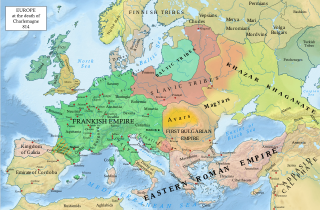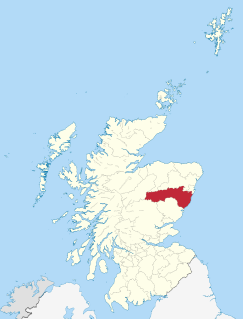
Kincardine and Deeside was formerly (1975-96) a local government district in the Grampian Region of Scotland. In 1996 it was included in the Aberdeenshire unitary area.

The Neolithic long house was a long, narrow timber dwelling built by the first farmers in Europe beginning at least as early as the period 5000 to 6000 BC. They first appeared in central Europe in connection with the early Neolithic cultures such as the Linear Pottery culture or Cucuteni culture. This type of architecture represents the largest free-standing structure in the world in its era. Long houses are present across numerous regions and time periods in the archaeological record.

Cairn O' Mounth/Cairn O' Mount is a high mountain pass in Aberdeenshire, Scotland. The place name is a survival of the ancient name for what are now the Grampian Mountains, earlier called "the Mounth". The name change happened from circa 1520 AD. The Ordnance Survey shows the name as Cairn o' Mount.
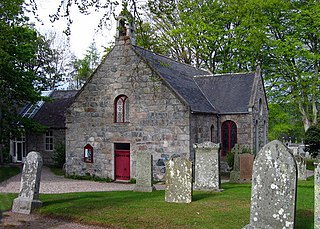
Maryculter or Kirkton of Maryculter is a village in the Lower Deeside area of Aberdeenshire, Scotland. The River Dee separates it from the town of Peterculter, and the B979 road runs through Maryculter. There are two hotels: The Old Mill Inn, a former coaching inn that dates back 200 years, and Maryculter House Hotel. At the edge of the village of Maryculter is a public forest land, known as the Oldman Wood, through which flows the Crynoch Burn. Also the children's theme park, StoryBook Glen, which also consists of a shop and restaurant is located near the old church which is still in use today as a Church of Scotland. Other notable vicinity buildings are the Lairhillock Inn and Muchalls Castle. Maryculter also has an animal sanctuary, Blaikiewell Animal Sanctuary.

Findon or Finnan is a fishing village eight miles south of Aberdeen, famous for originating the smoked haddock known as Finnan haddie. The Findon moor has a number of paths through it, many of which run along the cliffs. Deer can often be seen there. Nearby features include the Portlethen Moss Nature Reserve.

Ury House is a large ruined mansion in Aberdeenshire, Scotland, built in the Elizabethan style in 1885 by Sir Alexander Baird, 1st Baronet. It is situated on the north-east coast about 1 mile (1.6 km) north of Stonehaven in the former county of Kincardineshire.
Downies is a cliff-top village in Aberdeenshire, Scotland situated on Cammachmore Bay. Historically Downies was a fishing village, until much of the local North Sea fishery collapsed from overfishing; presently Downies is chiefly a residential dormitory adjunct to the city of Aberdeen.
Nigg is an area of Aberdeen, Scotland, south of the River Dee. The area has a bay known as the Bay of Nigg or Nigg Bay, immediately south of a coastal golf course, and a farm that is also a visitor attraction, known as Doonies Farm.

Bridge of Muchalls is an entirely residential hamlet in Aberdeenshire, Scotland by the North Sea. It is on the A90 dual carriageway about three miles north of Stonehaven and to the south of Muchalls Castle.
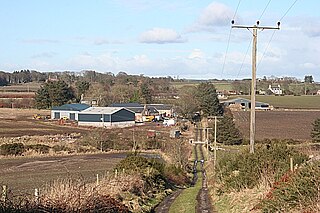
The Causey Mounth is an ancient drovers' road over the coastal fringe of the Grampian Mountains in Aberdeenshire, Scotland. This route was developed as the main highway between Stonehaven and Aberdeen around the 12th century AD and it continued to function as the principal route connecting these two cities until the mid 20th century, when modern highway construction of the A90 road occurred in this area. There are extant paved and usable sections of this road over part of the alignment; however, many parts of the ancient route are no more than footpaths, and in some cases the road has vanished into agricultural fields. Constructed in the Middle Ages, the Causey Mounth was created as an elevated rock causeway to span many of the boggy areas such as the Portlethen Moss. A considerable portion of the alignment of the Causey Mounth is illustrated on the UK Ordnance Survey Map, although a large fraction of the route cannot be navigated by a conventional passenger vehicle.

Elsick House is an historic house in Kincardineshire, northeast Scotland.
Cammachmore is a hamlet in the coastal region near the North Sea in Aberdeenshire. It lies slightly west of the A90 road and the ancient Causey Mounth passes through the community. Historic Elsick House is situated due west of Cammachmore. Other nearby historic features include Gillybrands, Saint Ternan's Church, Muchalls Castle and the Lairhillock Inn.
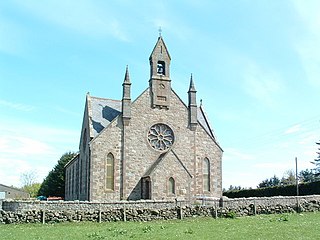
Cookney is a hamlet in Aberdeenshire, Scotland in proximity to Netherley in the Mounth of the Grampian Highlands. The community is situated on a hilltop approximately five miles northwest of Stonehaven and about three miles northwest of the Bridge of Muchalls. Cookney lies about two miles west of Muchalls Castle. From Cookney a portion of the ancient route of the Causey Mounth is visible to the east near Whinward Farm, although the track is not truly recognizable from that distance of about two miles. The Cookney Church is a prominent historic landmark of Cookney.
Banchory-Devenick is a village approximately two kilometres south of the city of Aberdeen, Scotland in the Lower Deeside area of Aberdeenshire. The village should not be confused with the historic civil parish of the same name which spanned the River Dee until 1891, its northern part lying in Aberdeenshire and its southern part in Kincardineshire. In that year the northern part became part of the neighbouring parish of Peterculter, the southern part remaining as the parish of Banchory-Devenick. The village of Banchory-Devenick lies slightly west of the A90 road, and the ancient Causey Mounth passes directly through the village. An historic graveyard dating to 1157 AD is present at the village of Banchory-Devenick. Other historic features in the vicinity include Saint Ternan's Church, Muchalls Castle and the Lairhillock Inn.
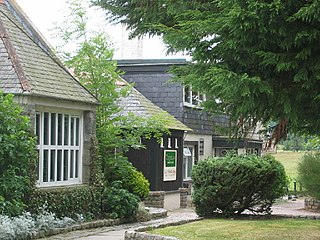
The Lairhillock Inn is an historic coaching inn along an old carriage route approximately four miles north of Netherley, Aberdeenshire, Scotland.
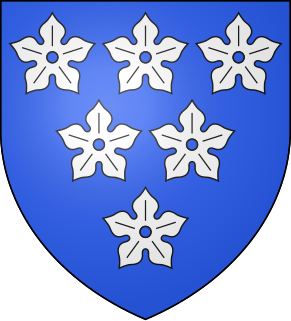
Alexander Fraser of Touchfraser and Cowie was a member of the Scottish nobility who served as the Lord Chamberlain of Scotland and also as the Sheriff of Stirling and Sheriff of Kincardine. He was a descendant of the Clan Fraser members deriving from Oliver Castle. Alexander died at the Battle of Dupplin Moor.
The Barony of Cowie is a geographical and political division of land in Aberdeenshire, Scotland deriving from the Middle Ages. King Robert the Bruce conferred these lands of the Barony of Cowie, along with the Barony of Cluny and the Barony of Kinnaird upon Alexander Fraser of Touchfraser and Cowie, who was his Chamberlain at least as late as 1319 AD. The major transport route across the Barony of Cowie in the Middle Ages was an ancient trackway known as the Elsick Mounth,

Kindrochit Castle is a ruined 14th-century fortification in Aberdeenshire, Scotland. It is located at Braemar, in a strategic position on the banks of the Clunie Water, a tributary of the River Dee. The ruins are protected as a scheduled monument.
The Mill of Muchalls is an historic water powered mill located along the Burn of Muchalls in Aberdeenshire, Scotland. This mill is situated near to the coast of the North Sea proximate to Doonie Point. The earliest position of the village of Muchalls lay slightly to the south of the Mill of Muchalls. The Mill of Muchalls is situated slightly to the east of the ancient Causey Mounth trackway, a drovers' road established at least as early as the High Middle Ages.

